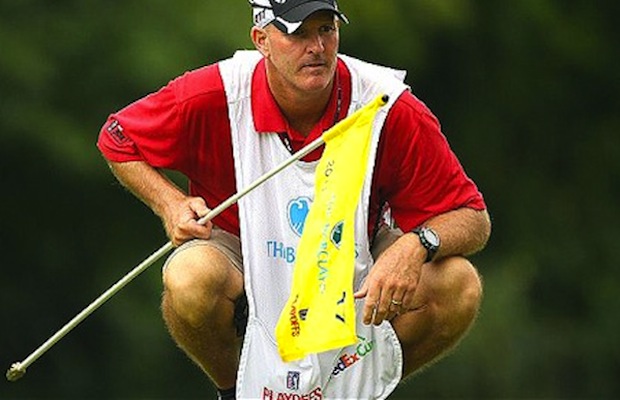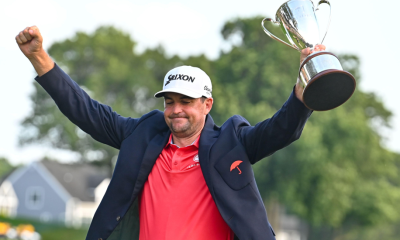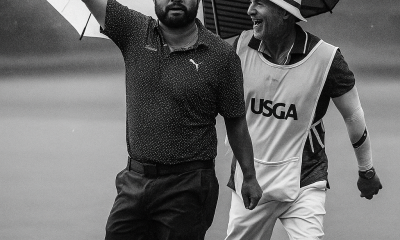Opinion & Analysis
Carry on: Tour caddies make the right move in organizing APTC

So this is what happens when they cancel the caddie races. Many of the most high-profile caddies in professional golf, as well as members of the rank and file, have banded together to form the Association of Professional Tour Caddies (APTC) in order to create both a unified voice and lobby.
Now, before you say, “These guys get paid hundred of thousands of dollars to carry a bag,” it’s important to remember that professional caddies do much more than merely hand a player his/her club; they are vital to the success of professional golfers.
One of the best brief summaries of the roles caddie play beyond charting courses, giving yardages, and carrying bags was written by Larry Dorman in the New York Times during the course of the Tiger Woods-Steve Williams split:
“[Caddies] are traffic cops, psychiatrists and meteorologists. They are chauffeurs, butlers, and bodyguards, buddies, sidekicks and frequent dinner companions. When things get really tough, they are guard dogs, attack dogs.”
The “dogs” are often not treated with the same level of respect by tournament hosts and venues as players.
At The Barclays, according to APTC President James Edmondson, the following occurred during a rain delay:
“A security guy came in, started berating us, asking to see everyone’s ID, and then began kicking out our families into the rain. We all thought, ‘Would they ever do this to the players in their area?’ That’s when we decided to have a meeting.”
The result of that meeting, attended by half of the caddies looping in New York that week: a unanimous vote to become an association. The group hired the law firm of Barlow, Garsek & Simon to represent them and established a board of caddies, which includes Tiger Woods’ caddie, Joe LaCava.
As Christian Dennie, an attorney for the caddies said:
The caddies play an instrumental role in the success of tour players and the success of professional golf. In an effort to further their profession, caddies have united to provide more information about their role in professional golf and obtain group benefits that will allow them to have retirement accounts and health care like many Americans who watch golf each week.
Standard pay for a caddie on the PGA Tour is a $1,000 a week plus 5-to-10 percent of a player’s winnings. Sure, if you’re Joe LaCava, Steve Williams, Fluff Cowan, or Bones Mackay, maybe you’re making close to seven figures. But what if you’re carrying a bag for Ken Duke, 50th on the PGA Tour money list at $1,722,583, making 5-to-10 percent of that number plus $1000 a week? Or Casey Wittenberg, 150th on the money list at $425,395?
Carrying a bag on tour beats the proverbial burger flipping from a financial point of view to be sure, but what of benefits, health insurance, retirement accounts, etc? As caddies aren’t formally employed by the Tour, they aren’t recipients of standard benefits afforded to employees of a large, immensely profitable organization.
It’s appropriate to remember, too, that prior to Walter Hagen’s 1920 Open Championship dressing-in-his-limousine stunt (and the succeeding U.S. Open), touring pros weren’t even permitted to change in the host club’s locker room. Beyond this specific formal barrier, the men placing pegs in the ground were generally treated more like traveling circus performers than revered athletes.
The PGA Tour itself—which, among many other things, contributed to reversing the above—was only formed in the late 1960 as money from television contracts began to pour into the pockets of the PGA of America. It was at this point that those entertaining Americans on the fairways collectively stood up and said they felt they ought to rewarded appropriately for their efforts.
Professional caddies are faced with a similar situation today: needing to formally legitimize a profession that has evolved and become quite legitimate in significant ways but hasn’t in equally significant others.
Long gone are the days of a pro picking the local caddie from the pit to schlep his bag for the week. It’s time for professional tour caddies to be appropriately organized and represented, and the APTC is the right move.
Opinion & Analysis
The 2 primary challenges golf equipment companies face

As the editor-in-chief of this website and an observer of the GolfWRX forums and other online golf equipment discourse for over a decade, I’m pretty well attuned to the grunts and grumbles of a significant portion of the golf equipment purchasing spectrum. And before you accuse me of lording above all in some digital ivory tower, I’d like to offer that I worked at golf courses (public and private) for years prior to picking up my pen, so I’m well-versed in the non-degenerate golf equipment consumers out there. I touched (green)grass (retail)!
Complaints about the ills of and related to the OEMs usually follow some version of: Product cycles are too short for real innovation, tour equipment isn’t the same as retail (which is largely not true, by the way), too much is invested in marketing and not enough in R&D, top staffer X hasn’t even put the new driver in play, so it’s obviously not superior to the previous generation, prices are too high, and on and on.
Without digging into the merits of any of these claims, which I believe are mostly red herrings, I’d like to bring into view of our rangefinder what I believe to be the two primary difficulties golf equipment companies face.
One: As Terry Koehler, back when he was the CEO of Ben Hogan, told me at the time of the Ft Worth irons launch, if you can’t regularly hit the golf ball in a coin-sized area in the middle of the face, there’s not a ton that iron technology can do for you. Now, this is less true now with respect to irons than when he said it, and is less and less true by degrees as the clubs get larger (utilities, fairways, hybrids, drivers), but there remains a great deal of golf equipment truth in that statement. Think about it — which is to say, in TL;DR fashion, get lessons from a qualified instructor who will teach you about the fundamentals of repeatable impact and how the golf swing works, not just offer band-aid fixes. If you can’t repeatably deliver the golf club to the golf ball in something resembling the manner it was designed for, how can you expect to be getting the most out of the club — put another way, the maximum value from your investment?
Similarly, game improvement equipment can only improve your game if you game it. In other words, get fit for the clubs you ought to be playing rather than filling the bag with the ones you wish you could hit or used to be able to hit. Of course, don’t do this if you don’t care about performance and just want to hit a forged blade while playing off an 18 handicap. That’s absolutely fine. There were plenty of members in clubs back in the day playing Hogan Apex or Mizuno MP-32 irons who had no business doing so from a ballstriking standpoint, but they enjoyed their look, feel, and complementary qualities to their Gatsby hats and cashmere sweaters. Do what brings you a measure of joy in this maddening game.
Now, the second issue. This is not a plea for non-conforming equipment; rather, it is a statement of fact. USGA/R&A limits on every facet of golf equipment are detrimental to golf equipment manufacturers. Sure, you know this, but do you think about it as it applies to almost every element of equipment? A 500cc driver would be inherently more forgiving than a 460cc, as one with a COR measurement in excess of 0.83. 50-inch shafts. Box grooves. And on and on.
Would fewer regulations be objectively bad for the game? Would this erode its soul? Fortunately, that’s beside the point of this exercise, which is merely to point out the facts. The fact, in this case, is that equipment restrictions and regulations are the slaughterbench of an abundance of innovation in the golf equipment space. Is this for the best? Well, now I’ve asked the question twice and might as well give a partial response, I guess my answer to that would be, “It depends on what type of golf you’re playing and who you’re playing it with.”
For my part, I don’t mind embarrassing myself with vintage blades and persimmons chasing after the quasi-spiritual elevation of a well-struck shot, but that’s just me. Plenty of folks don’t give a damn if their grooves are conforming. Plenty of folks think the folks in Liberty Corner ought to add a prison to the museum for such offences. And those are just a few of the considerations for the amateur game — which doesn’t get inside the gallery ropes of the pro game…
Different strokes in the game of golf, in my humble opinion.
Anyway, I believe equipment company engineers are genuinely trying to build better equipment year over year. The marketing departments are trying to find ways to make this equipment appeal to the broadest segment of the golf market possible. All of this against (1) the backdrop of — at least for now — firm product cycles. And golfers who, with their ~15 average handicap (men), for the most part, are not striping the golf ball like Tiger in his prime and seem to have less and less time year over year to practice and improve. (2) Regulations that massively restrict what they’re able to do…
That’s the landscape as I see it and the real headwinds for golf equipment companies. No doubt, there’s more I haven’t considered, but I think the previous is a better — and better faith — point of departure when formulating any serious commentary on the golf equipment world than some of the more cynical and conspiratorial takes I hear.
Agree? Disagree? Think I’m worthy of an Adam Hadwin-esque security guard tackle? Let me know in the comments.
@golfoncbs The infamous Adam Hadwin tackle ? #golf #fyp #canada #pgatour #adamhadwin ? Ghibli-style nostalgic waltz – MaSssuguMusic
Podcasts
Fore Love of Golf: Introducing a new club concept

Episode #16 brings us Cliff McKinney. Cliff is the founder of Old Charlie Golf Club, a new club, and concept, to be built in the Florida panhandle. The model is quite interesting and aims to make great, private golf more affordable. We hope you enjoy the show!
Opinion & Analysis
On Scottie Scheffler wondering ‘What’s the point of winning?’

Last week, I came across a reel from BBC Sport on Instagram featuring Scottie Scheffler speaking to the media ahead of The Open at Royal Portrush. In it, he shared that he often wonders what the point is of wanting to win tournaments so badly — especially when he knows, deep down, that it doesn’t lead to a truly fulfilling life.
View this post on Instagram
“Is it great to be able to win tournaments and to accomplish the things I have in the game of golf? Yeah, it brings tears to my eyes just to think about it because I’ve literally worked my entire life to be good at this sport,” Scheffler said. “To have that kind of sense of accomplishment, I think, is a pretty cool feeling. To get to live out your dreams is very special, but at the end of the day, I’m not out here to inspire the next generation of golfers. I’m not out here to inspire someone to be the best player in the world, because what’s the point?”
Ironically — or perhaps perfectly — he went on to win the claret jug.
That question — what’s the point of winning? — cuts straight to the heart of the human journey.
As someone who’s spent over two decades in the trenches of professional golf, and in deep study of the mental, emotional, and spiritual dimensions of the game, I see Scottie’s inner conflict as a sign of soul evolution in motion.
I came to golf late. I wasn’t a junior standout or college All-American. At 27, I left a steady corporate job to see if I could be on the PGA Tour starting as a 14-handicap, average-length hitter. Over the years, my journey has been defined less by trophies and more by the relentless effort to navigate the deeply inequitable and gated system of professional golf — an effort that ultimately turned inward and helped me evolve as both a golfer and a person.
One perspective that helped me make sense of this inner dissonance around competition and our culture’s tendency to overvalue winning is the idea of soul evolution.
The University of Virginia’s Division of Perceptual Studies has done extensive research on reincarnation, and Netflix’s Surviving Death (Episode 6) explores the topic, too. Whether you take it literally or metaphorically, the idea that we’re on a long arc of growth — from beginner to sage elder — offers a profound perspective.
If you accept the premise literally, then terms like “young soul” and “old soul” start to hold meaning. However, even if we set the word “soul” aside, it’s easy to see that different levels of life experience produce different worldviews.
Newer souls — or people in earlier stages of their development — may be curious and kind but still lack discernment or depth. There is a naivety, and they don’t yet question as deeply, tending to see things in black and white, partly because certainty feels safer than confronting the unknown.
As we gain more experience, we begin to experiment. We test limits. We chase extreme external goals — sometimes at the expense of health, relationships, or inner peace — still operating from hunger, ambition, and the fragility of the ego.
It’s a necessary stage, but often a turbulent and unfulfilling one.
David Duval fell off the map after reaching World No. 1. Bubba Watson had his own “Is this it?” moment with his caddie, Ted Scott, after winning the Masters.
In Aaron Rodgers: Enigma, reflecting on his 2011 Super Bowl win, Rodgers said:
“Now I’ve accomplished the only thing that I really, really wanted to do in my life. Now what? I was like, ‘Did I aim at the wrong thing? Did I spend too much time thinking about stuff that ultimately doesn’t give you true happiness?’”
Jim Carrey once said, “I think everybody should get rich and famous and do everything they ever dreamed of so they can see that it’s not the answer.”
Eventually, though, something shifts.
We begin to see in shades of gray. Winning, dominating, accumulating—these pursuits lose their shine. The rewards feel more fleeting. Living in a constant state of fight-or-flight makes us feel alive, yes, but not happy and joyful.
Compassion begins to replace ambition. Love, presence, and gratitude become more fulfilling than status, profits, or trophies. We crave balance over burnout. Collaboration over competition. Meaning over metrics.
Interestingly, if we zoom out, we can apply this same model to nations and cultures. Countries, like people, have a collective “soul stage” made up of the individuals within them.
Take the United States, for example. I’d place it as a mid-level soul: highly competitive and deeply driven, but still learning emotional maturity. Still uncomfortable with nuance. Still believing that more is always better. Despite its global wins, the U.S. currently ranks just 23rd in happiness (as of 2025). You might liken it to a gifted teenager—bold, eager, and ambitious, but angsty and still figuring out how to live well and in balance. As much as a parent wants to protect their child, sometimes the child has to make their own mistakes to truly grow.
So when Scottie Scheffler wonders what the point of winning is, I don’t see someone losing strength.
I see someone evolving.
He’s beginning to look beyond the leaderboard. Beyond metrics of success that carry a lower vibration. And yet, in a poetic twist, Scheffler did go on to win The Open. But that only reinforces the point: even at the pinnacle, the question remains. And if more of us in the golf and sports world — and in U.S. culture at large — started asking similar questions, we might discover that the more meaningful trophy isn’t about accumulating or beating others at all costs.
It’s about awakening and evolving to something more than winning could ever promise.






















Albert Sewill
Nov 20, 2013 at 9:22 am
It was only a matter of time before this happened! The modern caddy is very under-appreciated.
What a stupid I am!
Nov 13, 2013 at 10:42 pm
From Golf Digest’s September 2012 issue:
A FEW PROS make the tour an all-day, everyday job. For all the money in the world I couldn’t work for Vijay Singh. It would drive me crazy to stand there and watch a guy hit 7,000 golf balls a day–I couldn’t have watched Ben Hogan hit 7,000 golf balls a day. Paul Tesori is a former tour player who worked for Vijay until Vijay called him one Christmas morning to see if he wanted to meet at the range. Paul said working 366 days a year was a bit much. He’s now working closely with Webb Simpson.
http://www.golfdigest.com/magazine/2012-09/mark-long-stories#ixzz2kaUtNCS5
jeev
Nov 11, 2013 at 11:21 am
Mods! I see a politically charged post that should be edited/removed!
snowman0157
Nov 10, 2013 at 4:54 pm
ok, no offense.. it is low-skilled labor. So if they choose to caddie, travel a lot, work on commission and pay their own expenses, for 50K / yr gross, god bless ’em. They probably like the lifestyle. If not, get another skill and stay home. Nobody owes nobody a certain standard of living.
Enabler
Nov 8, 2013 at 4:10 pm
Caddy can make a huge impact on the performance of the player. The role of the touring caddy is much like coaching and staff for other sports. Anyone who travels 30 weeks a year no matter the perks sacrifices traditional life relationships with children and family. The PGA should evaluate the situation and offer up recognition to the profession and their role in the tour. Appears it is another example of squeaky wheel gets oil… This organization should help the profession. It is past time the members of the PGA recognizes the touring caddy significance to this sport.
AJ
Nov 8, 2013 at 9:33 am
Just a fairly amusing note regarding caddies – one of the guys at my club (Scottish fella) is good mates with Alistair McLean, tour caddie to Colin Montgomerie for a number of years.
Regarding the ‘hiring and firing’ process, Alistair recently worked for Henrik Stenson (post Monty, after Fanny retired) and effectively ‘sacked’ Stenson because he wasn’t playing well enough.
Safe to say a couple of years after that sacking, he regrets the move!
CWA
Nov 7, 2013 at 11:04 pm
CWA!!!!!
Mike M
Nov 7, 2013 at 8:07 pm
I think this is great for the caddies, its going to help them a lot with their careers. i don’t think its right that ernie els has a caddie becomes friends with dan quinn and then drops his regular caddie… contracts contracts contracts !
rB
Nov 11, 2013 at 6:52 pm
AJ, I have known EE for 20 years and RR during that span..
… there is aLOT more to their history than Ernie meeting DQ.!!
Sometimes change is a good thing..
Unbelievable!
Nov 7, 2013 at 7:41 pm
There are MASSIVE amounts of people who work WAY harder for a lot less. All of you guys saying 50,000 a year isn’t a lot of money… It’s about 900 a week….
That’s 22.50 an hour for a 40 hour job.
50,000 is probably above average pay for entry level management in most major corporations….
That’s average pay for Electricians… Plumbers… Framers…
It’s more than most Teachers, Fireman, Police Officers… Public Defenders and Prosecuters…
Poor, sad, underpaid little caddie….
It’s great they banded together to help improve their lives… Bravo… It truly is needed and deserved… However… Stop complaining about the money…. You know what that is…
Pathetic.
Bobcat43
Nov 8, 2013 at 8:44 pm
I for one wouldn’t want to be on the road for 25-30+ weeks a year for $50k and deal with a Tour Pro’s every whim. When I was fresh out of college I was making far more than that for being on the road that much (back in the 90’s, and it wasn’t management). But obviously someone wants that job. And someone always will want that job.
But I will say that if Bones, Fluff or (insert any tour caddy) decide to price themselves out of the market. That’s their decision. I don’t watch professional golf to see them huck a bag and pitch grass in the air. Not to belittle their job, but someone will do their job and those great players will still be great.
And I cannot stress this point enough… the PGA TOUR is the players (not their caddies). Joe Lacava may be cool but he’s not the “Golden Goose”. Will Tiger have to cross a picket line on the first tee? No.
When a minority share partner tries to force the majority share partner to act, it will go poorly for the minority share partner. Frankly, below average tour caddies just like below average tour players should make less less (relatively speaking). It keeps the ranks fresh and the competition strong.
john flavia
Nov 7, 2013 at 4:06 pm
This has started me thinking in another way.
The touring pro’s have it pretty good, I’ve read how their retirement packages are second to none, certainly the NFL, NBA, MLB doesn’t even compare (something like $10,000 gets added to their retirement accounts for every tournament they make the cut?). The PGA just announced they have raised the PGA Championship purse to $10 mill, the most of any tournament/major and has recently been boasting about $1 billion for charity raised. So you’re telling me that you have done nothing in all this time for the working man of the industry, the caddy?, to improve them?
Wyatt
Nov 9, 2013 at 8:25 am
They work more then 40hour a week. Plus has to pay all of their own expenses… You guys do not know the facts unless you are in the profession. Quit JUDGING. The PGA DOES NOTHING for the caddies at all no retirement either… The player if “vested” will retire a millionaire because they get money from the PGA… No where does the caddies get any of this…
Ralph
Nov 7, 2013 at 3:14 pm
Ah the dark side of professional golf. Good for them for trying to improve their lot in life.
Professional golfers are independent contractors. Just as the caddies ultimately are. One can fire the other at a moments notice with no forewarning.
They’d better be careful for what they wish.
I foresee the day when local yokels once again come back into the caddy game. The day will come when the pro tours allow GPS and lasers during play. Might be a while.
Bobcat43
Nov 7, 2013 at 2:27 pm
Real quick… Are these guys forced into this job? Seems to me that schlepping a bag for Casey Whittenburg for $48k/yr is a crappy job. But I don’t think Casey puts a gun to anyone’s head either. But that’s my opinion there maybe someone who would do that job for free.
So either find a better player, negotiate better or just find a better job. As for the issues with kicking family members out into the rain. I’m sure that can be fixed or maybe there is another side to the story. Not sure we need to call in Richard Trumka.
Oh and health benefits! Really are you guys serious? Our Gov’t has already fixed that problem! Just like everything it will be free for all of us! (insert sarcastic smiley here)
So if being a Tour Caddy is such a crappy job why the heck would anyone ever do it?
GolferX
Nov 7, 2013 at 1:15 pm
I think its a great step forward for the caddies; there is an awful lot of money being made on the PGA Tour and its time for the caddies to get some security. However, that begs the question, who pays? If they get benefits, who pays? The Tour? That particular caddie’s player?
What happens when your player retires or moves on? What about the other Tours? We will have to see how this shakes out.
Fairways and Greens, my friends.
Double Mocha Man
Nov 7, 2013 at 12:10 pm
When I was a caddie I made a whopping $10 a bag and scored a Snickers candy bar at the turn if I was lucky.
Jon
Nov 7, 2013 at 1:54 pm
Congrats, Mocha Man. That’s quite a bit for someone who wants somebody to feel sorry for them.
Eric
Nov 7, 2013 at 11:56 am
breaking down the numbers.
Ken Duke – 28 events, $1,722,583.73 in winnings in 2013
Ken Duke’s caddie (if $1K per week, 5% for any winnings, 7% of top 10, and 10% for a win) – $172,377.14
Take into account that he is on the road 28 weeks a year on his own dime which probably cost him $30K-$40. That means his takehome is about $135K before taxes. Yes, this is still a lot of money, but not for the top 50 in his profession for the year. And $135K is nowhere near a “fortune”.
Ken
Nov 7, 2013 at 12:30 pm
I think you are forgetting about one crucial item…endorsements
john flavia
Nov 7, 2013 at 11:51 am
Also, when you make your calculations, remember most tour players probably only play 25 tournaments = 25 weeks, so if you use the Casey Whittenburg as the example: 2013 season = 27 tournaments & $425,395 in winnings, so at $1,000/week + 5% = $27,000 + $21,270 = 48,270.
The question of ‘who pays for caddy’s expenses’? will be a big part in determining if that is a decent salary for caddy for a low ranking tour player or not.
Wyatt
Nov 9, 2013 at 8:31 am
Caddies are responsible for all their own expenses. Ie: flight, hotel, food, car, gas… Etc… They are also responsible for their own insurance.. Ie: single plan $250-$500, family $500-$2000 A MONTH! Again know your facts quite speculating.
Zak Kozuchowski
Nov 7, 2013 at 11:46 am
Don’t forget the costs, guys. Just like tour players, caddies pay their own travel expenses.
Evan
Nov 7, 2013 at 11:41 am
I completely agree with David here. If you are Ken Duke’s Caddy and making the lower 5%, you are still clearing $100k/year. if its 10%, go ahead and bump that to around $200k a year.
David
Nov 7, 2013 at 11:34 am
“Standard pay for a caddie on the PGA Tour is a $1,000 a week plus 5-to-10 percent of a player’s winnings. Sure, if you’re Joe LaCava, Steve Williams, Fluff Cowan, or Bones Mackay, maybe you’re making close to seven figures. But what if you’re carrying a bag for Ken Duke, 50th on the PGA Tour money list at $1,722,583, making 5-to-10 percent of that number plus $1000 a week? ”
I don’t understand the question… that’s an absolute FORTUNE.
john flavia
Nov 7, 2013 at 11:45 am
Do caddies pay for their own expenses out of their weekly/winnings-percentage? OR is that additionally compt’d by the player? If they have to pay for their travel/hotel/food accomodations, then that can eat up most, if not all of the $1,000, unless they are sleeping in shared rooms, etc, and eating minimal meals at fast food joints, imo.
When I go to my annual meetings (4-day trip), even when I try to keep expenses down by staying in the not-so-hottest of hotels, try not to eat fancy dinners, I can’t seem to get away with less than ~$1,200 or so in expenses, including airfare.
Chris
Nov 7, 2013 at 11:52 am
They normally pay out of pocket. It helps if they have friends in different cities. My buddy stays with me when he comes to town. I can’t tell you how pumped he is to save that few hundred plus have a laundry machine at his disposal. I think he did about 6 loads when he came in a few months ago.
Wyatt
Nov 9, 2013 at 8:32 am
Yes they are responsible for all their own expenses… Airfare, hotel, food, car, gas, etc….
Chris
Nov 7, 2013 at 11:48 am
You’re completely neglecting the fact that they have to use that money to pay rent wherever they live plus the hotels/motels that they stay at 7 days a week when on the road. Factor in gas (keeping in mind that tourney’s tend to not be that close to the previous one), food and occasional airfare. They’re not making a fortune unless your pro is. They’re on the road all the time. My friend has been a caddie on tour for the past 3+ years. They had to go to web.com playoffs to keep their card. He talked to caddies there (the web.com loopers) and realized that he had it pretty good. Those guys make nothing. They split rooms and/or sleeping in cars some of the time.
Jay
Nov 7, 2013 at 12:35 pm
A general rule of thumb is that a private contractor bills out at about 3X what a salaried individual would make in the same role. This is due to differences in tax laws, holiday pay, sick time, ease of termination and numerous other issues. ALso, as he will work in 20+ states during the year he can look forward to a 500+ page tax return.
SO if you take Ken Dukes caddy at the mid range of the $100-$200k and say $150k, then that is the equivalent of $50k annually. In reality not very good pay for some one who is traveling 30 weeks out of the year.